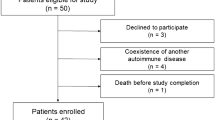Abstract
To determine serum interleukin-33 (IL-33) levels and their associations with clinical parameters in patients with systemic sclerosis (SSc). Serum IL-33 levels were examined by enzyme-linked immunosorbent assay in 69 patients with SSc and 30 healthy individuals. In a retrospective longitudinal study, sera from 14 patients with SSc were analyzed (follow-up, 1–7 years). Serum IL-33 levels were elevated in SSc patients (261.7 ± 141.9 pg/ml) compared with healthy individuals (174.9 ± 72.4 pg/ml; P < 0.001). Patients with diffuse cutaneous SSc had higher levels of IL-33 (287.5 ± 146.6 pg/ml) than those with limited cutaneous SSc (221.5 ± 126.5 pg/ml; P < 0.05). Pulmonary fibrosis and decreased forced vital capacity were more commonly found in patients with elevated IL-33 levels than in those with normal IL-33 levels. IL-33 levels correlated positively with the extent of skin sclerosis, and inversely with percent predicted forced vital capacity. IL-33 levels were increased in SSc patients and correlated with the extent of skin sclerosis and the severity of pulmonary fibrosis. Therefore, IL-33 possibly plays a role in cutaneous and pulmonary fibrosis in SSc patients.



Similar content being viewed by others
References
White B (1996) Immunopathogenesis of systemic sclerosis. Rheum Dis Clin Nor Am 32:695–708
Sato S (1999) Abnormalities of adhesion molecules and chemokines in scleroderma. Curr Opin Rheumatol 11:503–507
Needleman BW, Wigley FM, Stair RW (1992) Interleukin-1, interleukin-2, interleukin-4, interleukin-6, tumor necrosis factor-α, and interferon-γ levels in sera from patients with scleroderma. Arthritis Rheum 35:67–72
Famularo G, Procopio A, Giacomelli R et al (1990) Soluble interleukin-2 receptor, interleukin-2 and interleukin-4 in sera and supernatants from patients with progressive systemic sclerosis. Clin Exp Immunol 81:368–372
Hasegawa M, Fujimoto M, Kikuchi K, Takehara K (1997) Elevated serum levels of interleukin 4 (IL-4), IL-10, and IL-13 in patients with systemic sclerosis. J Rheumatol 24:328–332
Matsushita T, Hasegawa M, Hamaguchi Y, Takehara K, Sato S (2006) Longitudinal analysis of serum cytokine concentrations in systemic sclerosis: association of interleukin 12 elevation with spontaneous regression of skin sclerosis. J Rheumatol 33:275–284
Molteni M, Della Bella S, Mascagni B et al (1999) Increased interferon-gamma (IFN-γ) levels produced in vitro by alloactivated T lymphocytes in systemic sclerosis and Raynaud's phenomenon. Clin Exp Immunol 116:164–168
Grassegger A, Schuler G, Hessenberger G et al (1998) Interferon-gamma in the treatment of systemic sclerosis: a randomized controlled multicentre trial. Br J Dermatol 139:639–648
Schmitz J, Owyang A, Oldham E et al (2005) IL-33, an interleukin-1-like cytokine that signals via the IL-1 receptor-related protein ST2 and induces T helper type 2-associated cytokines. Immunity 23:479–490
Moussion C, Ortega N, Girard JP (2008) The IL-1-like cytokine IL-33 is constitutively expressed in the nucleus of endothelial cells and epithelial cells in vivo: a novel 'alarmin'? PLoS ONE 3:e3331
O'Neill LA, Dinarello CA (2000) The IL-1 receptor/toll-like receptor superfamily: crucial receptors for inflammation and host defense. Immunol Today 21:206–209
Komai-Koma M, Xu D, Li Y, McKenzie AN, McInnes IB, Liew FY (2007) IL-33 is a chemoattractant for human Th2 cells. Eur J Immunol 37:2779–2786
Xu D, Jiang HR, Kewin P et al (2008) IL-33 exacerbates antigen-induced arthritis by activating mast cells. Proc Natl Acad Sci USA 105:10913–10918
Palmer G, Talabot-Ayer D, Lamacchia C et al (2009) Inhibition of interleukin-33 signaling attenuates the severity of experimental arthritis. Arthritis Rheum 60:738–749
Subcommittee for Scleroderma Criteria of the American Rheumatism Association Diagnostic and Therapeutic Criteria Committee (1980) Preliminary criteria for the classification of systemic sclerosis (scleroderma). Arthritis Rheum 23:581–590
LeRoy EC, Krieg T, Black C et al (1988) Scleroderma (systemic sclerosis): classification, subsets, and pathogenesis. J Rheumatol 15:202–205
Steen VD, Powell DL, Medsger TAJ (1988) Clinical correlations and prognosis based on serum autoantibodies in patients with systemic sclerosis. Arthritis Rheum 31:196–203
Sato S, Ihn H, Kikuchi K, Takehara K (1994) Antihistone antibodies in systemic sclerosis: association with pulmonary fibrosis. Arthritis Rheum 37:391–394
Clements PJ, Lachenbruch PA, Seibold JR et al (1993) Skin thickness score in systemic sclerosis: an assessment of interobeservar variability in 3 independent studies. J Rheumatol 20:1892–1896
Roumm AD, Whiteside TL, Medsger TA Jr, Rodnan GP (1984) Lymphocytes in the skin of patients with progressive systemic sclerosis. Quantification, subtyping, and clinical correlations. Arthritis Rheum 27:645–653
Fleischmajer R, Perlish JS, Reeves JRT (1977) Cellular infiltrates in scleroderma skin. Arthritis Rheum 20:975–984
Scharffetter K, Lankat-Buttgereit B, Krieg T (1988) Localization of collagen mRNA in normal and scleroderma skin by in-situ hybridization. Eur J Clin Invest 18:9–17
Gillery P, Fertin C, Nicolas JF et al (1992) Interleukin-4 stimulates collagen gene expression in human fibroblast monolayer cultures. Potential role fibrosis. FEBS Lett 302:231–234
Chizzolini C (1999) T lymphocyte and fibroblast interactions: the case of skin involvement in systemic sclerosis and other examples. Springer Semin Immunopathol 21:431–450
Manetti M, Ibba-Manneschi L, Liakouli V et al (2010) The IL1-like cytokine IL33 and its receptor ST2 are abnormally expressed in the affected skin and visceral organs of patients with systemic sclerosis. Ann Rheum Dis 69:598–605
Acknowledgements
This work was supported by a grant from the Nakatomi Foundation.
Disclosures
None
Author information
Authors and Affiliations
Corresponding author
Rights and permissions
About this article
Cite this article
Yanaba, K., Yoshizaki, A., Asano, Y. et al. Serum IL-33 levels are raised in patients with systemic sclerosis: association with extent of skin sclerosis and severity of pulmonary fibrosis. Clin Rheumatol 30, 825–830 (2011). https://doi.org/10.1007/s10067-011-1686-5
Received:
Revised:
Accepted:
Published:
Issue Date:
DOI: https://doi.org/10.1007/s10067-011-1686-5




